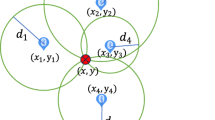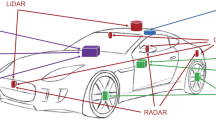Abstract
Indoor localization is a basic process in Wireless Sensor Networks (WSN) monitoring. This paper presents a new approach for localization of mobile nodes in WSNs. The proposed approach is based on the design of an adaptive fuzzy localization system. First proposed contribution is to consider the rooms of the target environment as a fuzzy sets made by adjacent zones described by a Fuzzy Location Indicator (FLI). FLI provides a fuzzy linearization of the building map hence the creation of a fuzzy linguistic model of the system. Fingerprints of the Radio Signal Strength Indicators (RSSI) are collected from different anchors according to each FLI. A Sugeno type-0 fuzzy inference system is proposed and submitted to a supervised learning through the neuro-fuzzy ANFIS algorithm. Simulation results as well as experimentations in Cynapsys company premises have proved that a good learning process leads to high success rate. Finally, a comparative study with two fuzzy localization systems proved the lower localization error average of the proposed approach.













Similar content being viewed by others
References
Progri, I. (2011). Geolocation of RF signals: Principles and simulations. Berlin: Springer. ISBN 978-1-4419-7951-3.
Liu, H., Darabi, H., Banerjee, P., &, Liu, J. (Nov 2007). Survey of wireless indoor positioning techniques and systems. IEEE Transactions on Systems, Man, and Cybernetics—Part C: Applications and Reviews, 37(16), 1067–1080.
Hu, Y., Zhou, W., Wen, Z., Sun, Y., & Yin, B. (2013). Efficient radio map construction based on low-rank approximation for indoor positioning. Mathematical Problems in Engineering, 2013(1461089), 1–9.
Li, X., Pahlavan, K., Latvaaho, M., &, Ylianttila, M. (Sep 2000). Indoor geolocation using OFDM signals in HIPERLAN/2 wireless LANs. In Proceedings PIMRC 2000 11th IEEE international symposium personal indoor and mobile radio communications, Vol. 2, pp. 1449–1453.
Gomez, J., Tayebi, A., del Corte, A., Gutierrez, O., Gomez, J. M., & Saezde Adana, F. (2013). A comparative study of localization methods in indoor environment. Wireless Personal Communications, 72(14), 2931–2944.
Kubota, R., Tagashira, S., Arakawa, Y., Kitasuka T., &, Fukuda, A. (2013). Efficient survey database construction using location fingerprinting interpolation. In 2013 IEEE 27th international conference on advanced information networking and applications (AINA), pp. 469–476.
Salazar, A. S., Aguilar, L., &, Licea, G. (2013). Estimating indoor zone-level location using Wi-Fi RSSI fingerprinting based on fuzzy inference system. In 2013 international conference on ICMEAE, pp. 19–22.
Luo, Q., Peng, Y., Peng, X., & Saddik, A. E. (2014). Uncertain data clustering-based distance estimation in wireless sensor networks. Sensors, 14(14), 6584–6605.
Narzullaev, A., Park, Y., &, Jung, H. (2008). Accurate signal strength prediction based positioning for indoor WLAN systems. In Proceedings of 2008 IEEE-ION position, location and navigation symposium, pp. 685–688.
Paul, A. S., & Wan, E. (Oct 2009). RSSI-based indoor localization and tracking using sigma-point Kalman smoothers. IEEE Journal of Selected Topics in Signal Processing, 3(15), 860–873.
Wang, Y., Guardiola, I. G., & Wu, X. (2014). RSSI and LQI data clustering techniques to determine the number of nodes in wireless sensor networks. International Journal of Distributed Sensor Networks, 1, 1–11.
Battiti, R., Brunato, M., &, Villani, A. (2002). Statistical learning theory for location fingerprinting in wireless LANs. In Department of information telecommunication technical report, Universita di Trento, Vol. 1.
Kulkarni, R., Forster, A., & Venayagamoorthy, G. (2011). Computational Intelligence in wireless sensor networks: A survey. IEEE Communications Surveys & Tutorials, 13(11), 68–96.
Goyal, S., & Patterh, M. S. (2014). Wireless sensor network localization based on cuckoo search algorithm. Wireless Personal Communications, 79(11), 223–234.
Kulkarni, R., Venayagamoorthy, G., &, Cheng, M. (2009). Bio-inspired node localization in wireless sensor networks. In IEEE international conference on systems, man and cybernetics, SMC, pp. 205–210.
Zadeh, L. A. (1993). The role of fuzzy logic and soft computing in the conception and design of intelligent systems. Berlin: Springer.
Baccar, N., & Bouallegue, R. (24–28 Aug 2015). A new fuzzy location indicator for Interval Type-2 indoor fuzzy localization system. In Proceedings of international wireless communications and mobile computing conference (IWCMC), pp. 126–131.
Garcia-Valverde, T., Garcia-Sola, A., Hagras, H., Dooley, J., Callaghan, V., & Botia, J. (2013). A fuzzy logic-based system for indoor localization using Wi-Fi in ambient intelligent environments. IEEE Transaction Fuzzy Systems, 21(14), 702–718.
Meng, W., Wang, J., Peng, L., &, Xu, Y. (Sep 2009). ANFIS-based wireless LAN indoor positioning algorithm. In 5th international conference on wireless communications, networking and mobile computing WiCom ‘09, pp. 1–4.
Xu, Y., Zhou, M., &, Ma, L. (Nov 2009). WiFi indoor location determination via ANFIS with PCA methods. In IEEE International conference on network infrastructure and digital content IC-NIDC 2009, pp. 647–651.
Payal, A., Rai, C. S., & Reddy, B. V. R. (2015). Analysis of some feedforward artificial neural network training algorithms for developing localization framework in wireless sensor networks. Wireless Personal Communication, 82(14), 2519–2536.
Witten, I., & Frank, E. (2005). Data mining: Practical machine learning tools and techniques. Burlington: Morgan Kaufmann.
Wang, B., & Zhou, S. (2015). Location search based on subarea fingerprinting and surface fitting for indoor positioning system. In 2015 IEEE 29th international conference on advanced information networking and applications (AINA), pp. 302–309.
Takagi, T., & Sugeno, M. (Jan–Feb 1985). Fuzzy identification of systems and its applications to modeling and control. IEEE Transactions on Systems, Man and Cybernetics, 1(11), 116–132.
Jang, J. S. (1993). ANFIS: Adaptive-network-based fuzzy inference system. IEEE Transactions on Systems, Man and Cybernetics, 23(13), 665–685.
Cynapsys, I. T. (2015). Cynapsys IT company. Cynapsys, 29 October 2015 [En ligne]. http://www.cynapsys.de/. Accessed 22 January 2016.
Chiu, S. L. (1994). Fuzzy model identification based on cluster estimation. Journal of Intelligent & Fuzzy Systems, 2(3), 267–278.
Acknowledgements
This work of research and innovation is made within a MOBIDOC thesis, financed by the European Union (EU) within the framework of the PASRI program and partially supported by Cynapsys IT Enterprise. Gratitude for all Cynapsys team: Mr Ammar Mr Tebourbi and Mr Kchaou. Also to the students M. Jridi, A. Soula and K. Barouni for their contributions in the experimentations.
Author information
Authors and Affiliations
Corresponding author
Rights and permissions
About this article
Cite this article
Baccar, N., Jridi, M. & Bouallegue, R. Adaptive Neuro-Fuzzy Location Indicator in Wireless Sensor Networks. Wireless Pers Commun 97, 3165–3181 (2017). https://doi.org/10.1007/s11277-017-4668-3
Published:
Issue Date:
DOI: https://doi.org/10.1007/s11277-017-4668-3




